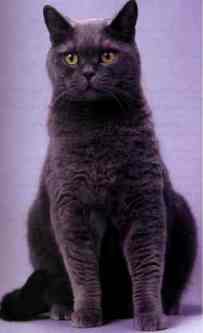
The British Shorthair Blue
|

The British Shorthair White |
The modern British Shorthair has been
developed from the ancient British working cats whose ancestors arrived
to Britain with the Romans somewhere between the first and fourth century
AD.
British Shorthair is a sturdy, muscular
cat with a massive, broad head, rather short neck and legs, and thick tail.
The coat, although short, is dense and plush. The traditional and most
popular color is blue, black is also one of the earliest colors. Today
almost every color is acceptable.
British Shorthair is said to be hardy,
good-natured, calm, affable, loyal, intelligent, reserved, prosaic, stolid,
loving, untemperamental, tranquil, dignified, independent and affectionate.
The main differences between European
and British Shorthairs are that the later ones have cobbier, sturdier bodies
with heavier, wider heads.
Further reading for British Shorthair lovers:
The British Shorthair Cat: Everything About Acquisition, Care Nutrition,
Behavior, Health Care, and Breeding (Complete Pet Ownwer's Manual) by
Friedhelm Lessmeier et al.
The British, European and American Shorthair Cat by Phyllis Lauder.

British Shorthair Lilac
|

British Shorthair Silver Tabby Blotched |
A famous British Shorthair
owner was Dick Whittington, the ex-Mayor of London.
 Not
many humans know how Whittington really became the Mayor of London, cats
know perfectly well. The human version of the story: “Dick is poor. Dick
works as servant. Dick gets a cat. Dick sells his cat. Dick becomes rich.
Oh-a-wak-fol-a-diddle-fol, etc.” Some humans speculate that the story is
not true. Huh, what do they know? Not
many humans know how Whittington really became the Mayor of London, cats
know perfectly well. The human version of the story: “Dick is poor. Dick
works as servant. Dick gets a cat. Dick sells his cat. Dick becomes rich.
Oh-a-wak-fol-a-diddle-fol, etc.” Some humans speculate that the story is
not true. Huh, what do they know?
The real story is much more complicated.
Dick is not a poor boy but, due to some problems with moneylenders, his
father bankrupted and soon afterwards, died of fever. And fourteen-year-old
Dick was left alone. Dick had been educated so he knew what to do, with
his last money, Dick paid to enter the service of a cat (humans crudely
put this as “bought a cat”). At the same time he became a cook’s assistant.
And thus he lived and worked for quite some time. Then, one day a captain
of a ship asked the cat whether he would like to go sailing, as they had
a vacancy of a rodent controller on the ship. The cat agreed. Dick was
sad to have the cat depart but the cat reassured him. And so the cat, which
I have to call ‘the cat’ because his real name is lost to history, sailed
off on the trip that would make Dick’s fortune. The cat didn’t return.
It presented its services as rat-catcher to the Moorish king, whose court
was overrun by rodents, and sent his big salary back to Dick. Dick became
rich and was appointed Mayor of London.
Moral: If you don’t serve a cat you’ll never succeed (or something
like this anyway)
|


 Not
many humans know how Whittington really became the Mayor of London, cats
know perfectly well. The human version of the story: “Dick is poor. Dick
works as servant. Dick gets a cat. Dick sells his cat. Dick becomes rich.
Oh-a-wak-fol-a-diddle-fol, etc.” Some humans speculate that the story is
not true. Huh, what do they know?
Not
many humans know how Whittington really became the Mayor of London, cats
know perfectly well. The human version of the story: “Dick is poor. Dick
works as servant. Dick gets a cat. Dick sells his cat. Dick becomes rich.
Oh-a-wak-fol-a-diddle-fol, etc.” Some humans speculate that the story is
not true. Huh, what do they know?